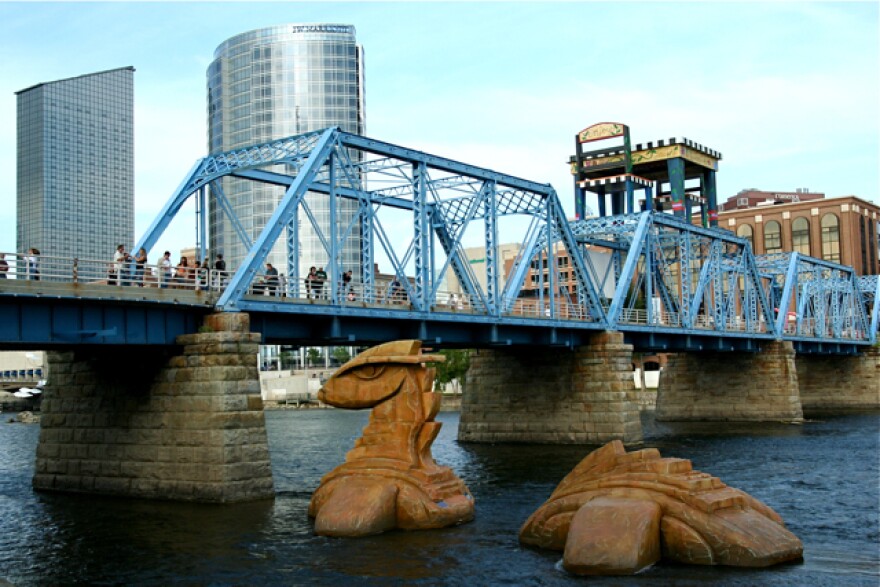ArtPrize 2012 has opened in Grand Rapids.
It's the fourth time round for the huge art exhibition and contest. This year, more than 1,500 artists are competing for $560,000 in prize money. And it's all there--from art that inspires to art that could outrage--and it does get folks talking.
Cyndy spoke with ArtPrize founder Rick DeVos.
She wanted to know how ArtPrize differs from shows like the Ann Arbor Art Fairs?
The main difference, he said, was that it’s not specifically a marketplace.
“There are things on the sides of buildings here; there are things in the river.”
Although artists can and do sell work, it’s an art prize competition first, and those funds are allocated by public vote.
DeVos said he originally looked into doing a film festival because he loved their democratic feel.
“People vote with their butts in their seats,” he said.
At Art Prize the voting occurs in two stages, and is accomplished in person or through a special smart phone app.
For the first week and a half people can vote for as many things as they want, said DeVos.
“Let’s say you see 200 pieces; you think five are worthy of recognition. You can vote for each one of those,” he said.
At the end of the first week and a half, voting is restricted to the top ten vote getters of the first round. Individuals then get one vote to select from the top ten.
And these votes matter. First prize is $200,000, second is $50,000, and third is $25,000. The rest of the top ten receive $5,000 each.
There are also expanded juried prizes DeVos said. There are five $20,000 prizes and one $100,000 prize.
Cyndy noted how much the prizes must mean to artists.
While acknowledging that the money is significant, DeVos said for a lot of people the prize is not what they are going after.
“You can get so much engagement here,” he said.
He notes that over 160,000 people visited the Grand Rapids art museum during last year’s festival.
“There are very few places where you can go and have that sort of traffic,” he said.
Much of the event is about selling work and building relationships with a broader audience.
“The prize sets a direction, but a lot is freewheeling, it’s a somewhat fun and zany event,” he said.
Visitors must feel like their vote matters Cyndy said.
DeVos agreed, he said it’s an incentive “to talk to other people, convince people, and educate people.”
He wants people exploring new parts of city and hopes that some will be thinking about art for the first time.
Cyndy asked about new art fans and families.
DeVos said that ArtPrize was initially targeted to people in their 20s and 30s, but he loves the idea that it has inspired kids to take up painting and other creative activities.
“I have a very young daughter and I can’t wait to bring her around ArtPrize when she’s a little bit older,” he said.
Cyndy asked DeVos about a recent controversyinvolving Kalamazoo artist Gurmej Singh. His rendering of Sadam Hussein in effigy was unceremoniously disposed of by the owner of the B.O.B. exhibition space.
The unique thing about ArtPrize, said DeVos, is that it does not make curatorial decisions.
“If you are 18 and you can find a place to host you…you can be a part of ArtPrize,” he said.
Cyndy wanted to know if DeVos could understand how some content might be objectionable to families. DeVos has been quoted saying he welcomes “crazy crap,” as it often gets discussion started.
“As an art lover and a dad,” Cyndy asked, “when is crazy crap not art, and just crap?”
DeVos said it was an unfortunate choice of words, but that he is not making a judgment call. He just wants to see a great depth and breadth of art.
DeVos said he is extremely open-minded and that parents can navigate for their children.
“I am not the arbiter,” he said.
“Our goal was to welcome as much as possible.”
And, he noted, it’s not anything new in the art world.
Talking through the controversy is good, but at the same time “it’s a little boring” said DeVos.
Find out more about ArtPrize at their website.
There are two ways you can podcast "Stateside with Cynthia Canty"





